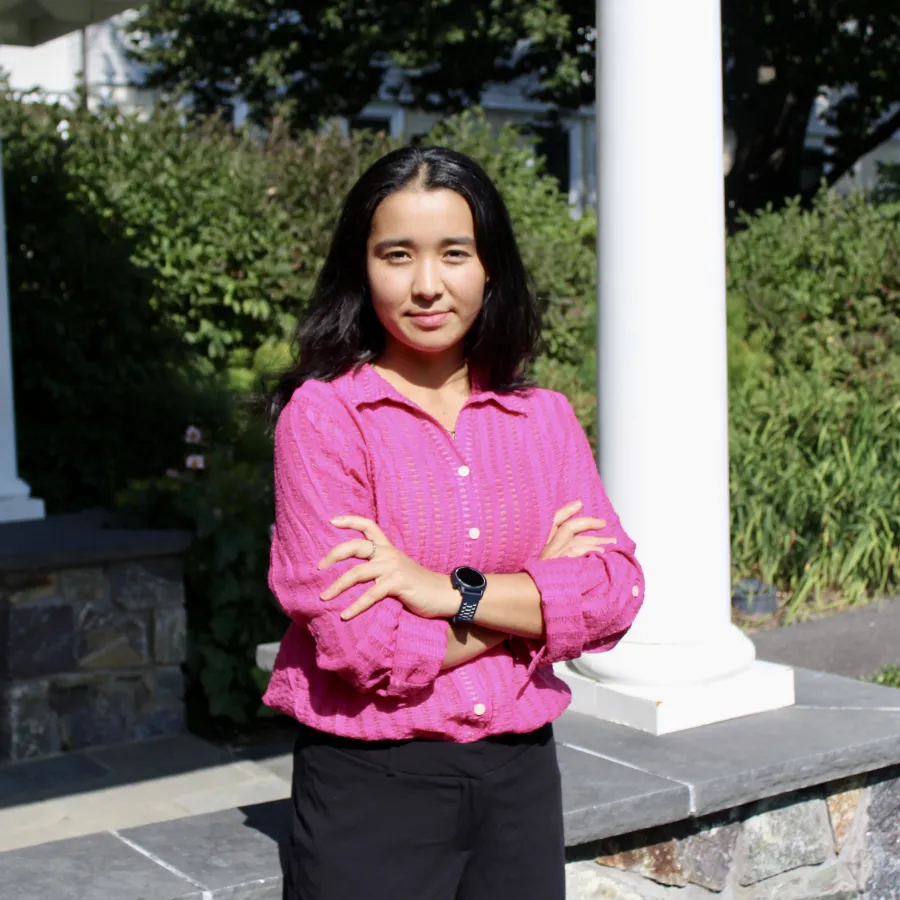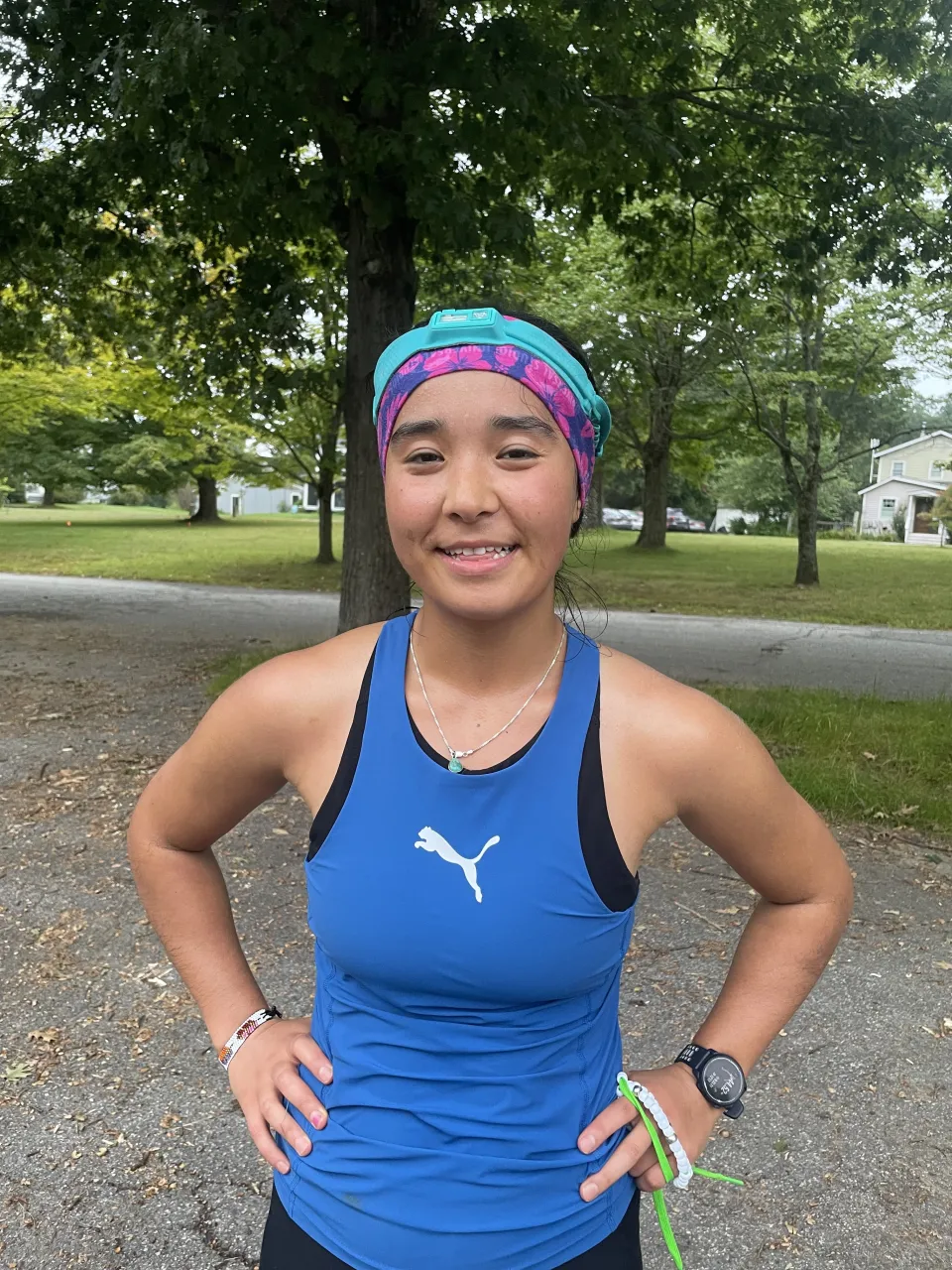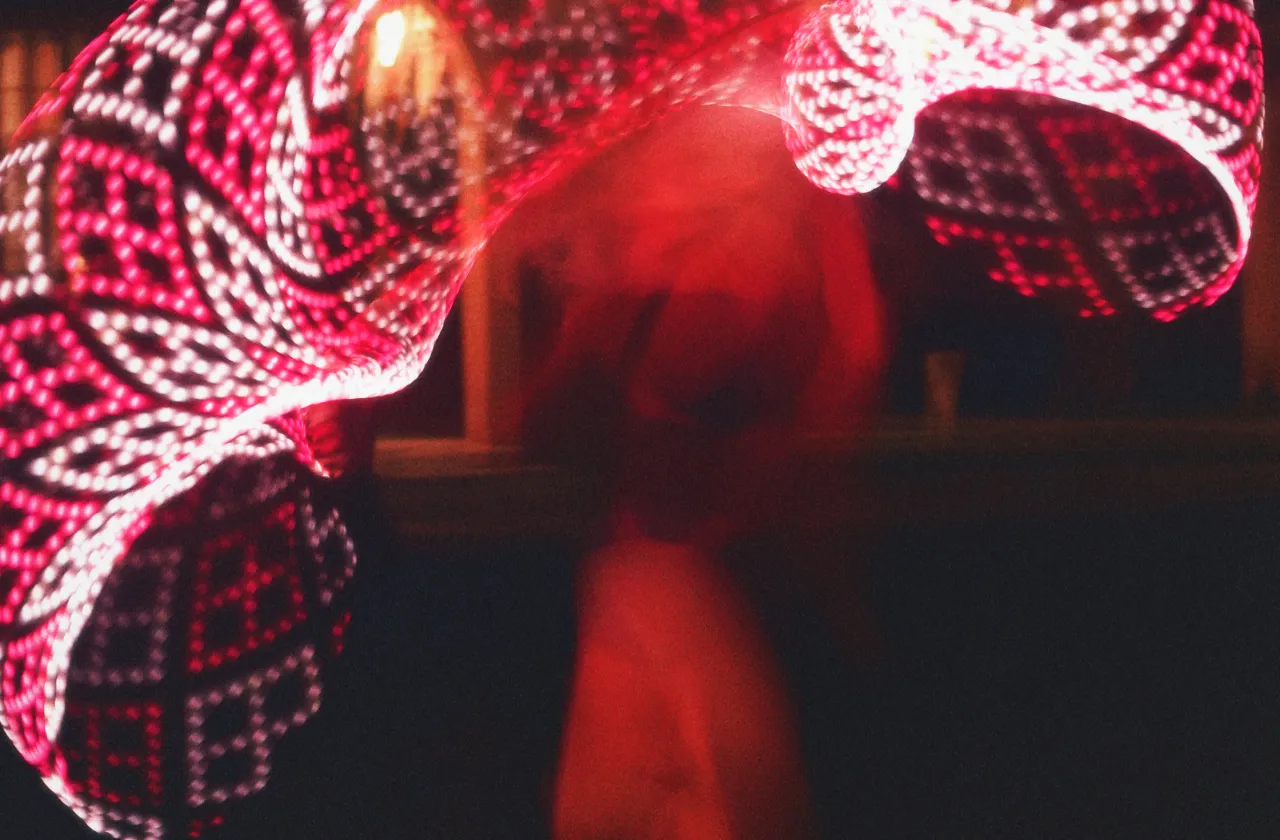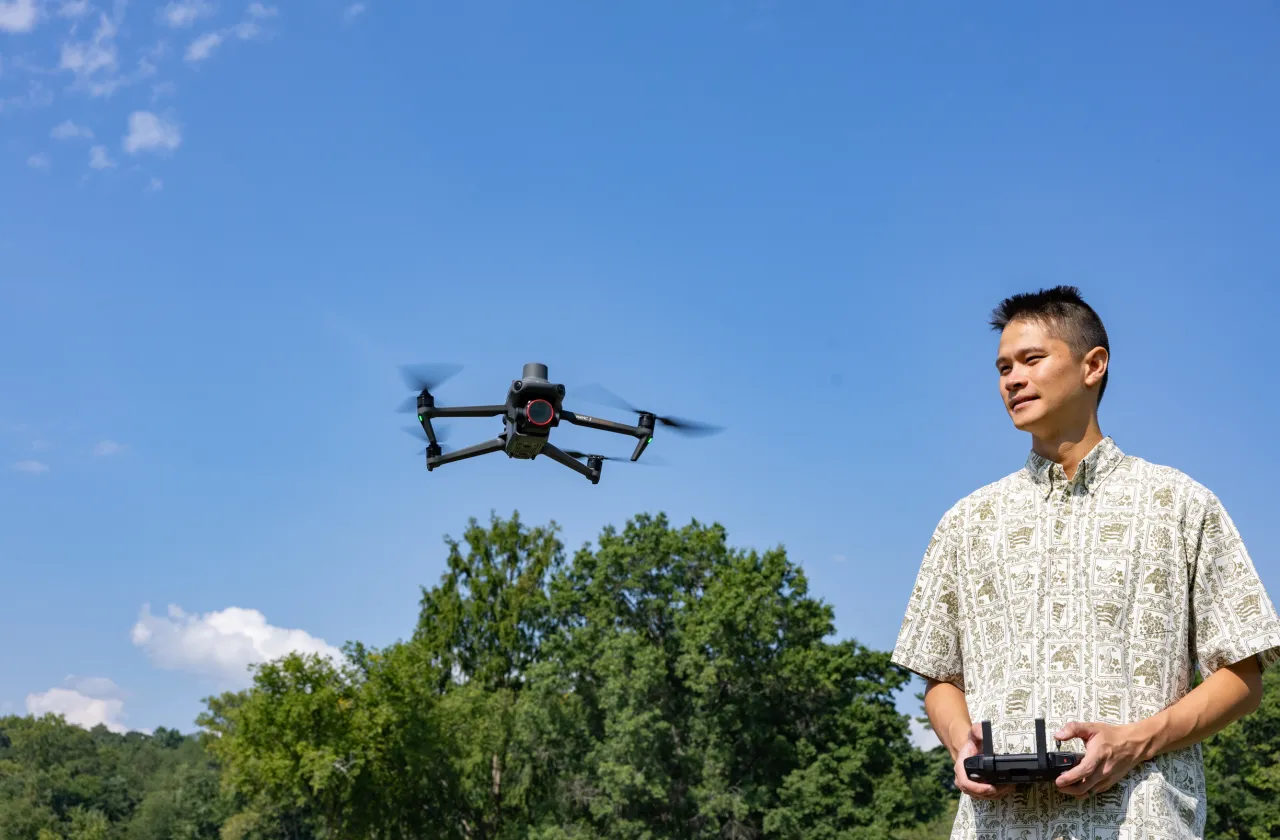Nadira Talayee’s Long, Dark Run
Students
An Afghan Smithie overcomes all obstacles to run her first ultramarathon

Published September 12, 2024
Before she took a single step in her first ultramarathon—in which she ran 44.52 miles in 12 hours, mostly in the dark—Nadira Talayee ’26 had already run further than she ever thought she could.
For Talayee, a statistical and data sciences major, running had never seemed like an option growing up. In Kabul, Afghanistan, where Talayee is from, the religious and cultural expectations meant that sports were highly discouraged, if not downright dangerous, for girls like her.
“The only form of running I did was playing tag with my friends outside our classroom or in the schoolyard,” Talayee says. “We stopped doing that after eighth grade because we grew up.”
In her middle school one day, Talayee was surprised to find fellow students gathered around a group of visitors. A U.S.-based nonprofit called Free to Run was looking to recruit Afghan girls who had strong academic and extracurricular backgrounds. The organization’s mission was to empower girls living in areas of conflict by giving them access to athletic opportunities like running.
Nominations were required, so Talayee hurried to the head of the school to plead her case.

Photo by Brooke Chandler ‘25
As a program participant, Talayee, then 14, would get up once a week in the predawn darkness full of excitement. She would grab her white school uniform and be picked up in a van with other Afghan girls from across the city. Singing and clapping to traditional tunes—with occasional hushes by the driver, who had been told to keep the noise low and the lights off for safety—the group of girls would head to a secure park on the outskirts of Kabul.
There, surrounded by barbed wire fencing, spotlights, and guards—but also trees and hills—they’d jog for a mile or two along the concrete roadways.
“Part of running at 4 o’clock in the morning was because it was the only time of the day we wouldn’t be seen outside,” says Talayee.“If we can’t run in the daylight, let’s go run when everyone is asleep and no one can see us.”
Between 2014 and 2021, Free to Run trained 900 Afghan girls—including Talayee and her group—according to Sarah Murray, the organization’s executive director. In Afghanistan now, Free to Run has scaled back to provide an underground indoor strength/fitness training program (which fly below the radar of the Taliban) for 200 participants. The program is called Omid, which means “hope” in Dari.
“We have to be hypervigilant about safety and security,” says Murray. “We often have informal agreements with park management and security to help ensure the safety of our participants.”
In all the countries where the organization operates, Free to Run encourages entry-level runners to use as much of their personal attire as they can. The group also provides running basics, such as sneakers and full-cover athletic attire.
That experience fits with Talayee’s memories of how she and other girls started in the program—running in boots and heavy winter coats, with hats to cover their faces. A friend of hers ran in flip-flops. One day, jogging in her leather school shoes, Talayee’s feet became painfully blistered, but she was more concerned about the condition of her shoes (and whether her parents would be angry about how she used them) than she was about her feet.
“I wonder how I didn’t get injured, but probably because we only ran once a week,” Talayee says. ”We were so excited, we didn’t think about all the other things.”
When Free to Run provided the group with sports bras and sneakers, Talayee picked out a purple and black pair of running shoes. They were slightly too small, so she removed the thick insoles and her mother made new ones. Talayee marveled at how soft the shoes were and wore them constantly.
“I remember running for the joy of it, mostly,” Talayee recalls. “Running because you can’t do that in your house or in your neighborhood—that was the fun part about it.”

Nadira Talayee after finishing her first ultramarathon
Inspired by her experience with the running nonprofit, Talayee and her brother briefly started a girls soccer program at their school and convinced their friends to train at a neighboring indoor gym. (The siblings teamed up again when they were college students in the United States to create EmpowerEd Afghan—a program that helps students in their home country by providing online English classes, test prep, and assistance with college applications. Pitched as “Empowering Afghan Girls,” the program’s premise won an award in the 2024 Elevator Pitch Contest sponsored by Smith’s Jill Ker Conway Innovation and Entrepreneurship Center.)
At age 15, Talayee was awarded a scholarship and moved across the world to Pennsylvania, where she attended a boarding school with impressive facilities. “I remember seeing the mowed grass and thinking, no one can stop me from running these soccer fields,” she says.
After the COVID-19 pandemic shuttered most spaces, Talayee started building up her running endurance by looping the school grounds. She eventually entered a virtual 5K and placed first in the women’s category (and second overall). A friend, who had been running with her, helped Talayee get recruited to their high school’s cross-country and track-and-field teams.
“I never had an issue with meeting the coaches’ expectations,” Talayee says with a laugh. “They would tell us to go run for 20 minutes and I would go run for 40 minutes.”
“I remember running for the joy of it, mostly. Running because you can’t do that in your house or in your neighborhood—that was the fun part about it.”
At Smith, Talayee opted out of joining a formal athletic team and instead worked with her friend Oliva Kraft ’25 to build the student-led Smith College Intercollegiate Running Club (SMIRC). The practices were informal, fun, and occasionally feats of endurance. One weekend, after Talayee and Kraft had run 16 miles, a friend joked that they should have finished the marathon. So the next weekend they did, pacing each other for four hours on a Sunday to go 26.5 miles—in a snowstorm.
“We have this joke: If you did it, I will do it, too,” says Talayee. “That’s how we did the marathon. I said, ‘I’m going to do it.’ And she said, ‘I’m going to do it, too.’”
Kraft says her friend is the “craziest” runner (a team compliment) and is impressive in the way she will run before 5 a.m. or run without music.
“She always gives great advice on form,” notes Kraft, “and I love the way Nadira approaches running. She pushes herself, but while also having fun and knowing her limits. She inspires me.”
This past summer, Talayee was missing her previous connection with other Afghan runners, so she got back in touch with Free to Run and was invited into their cohort of alumni ambassadors. On August 31, the day before she moved back to Chase House at Smith, Talayee joined the group for the start of a 12-hour ultramarathon called The Village Ultra in New Salem, Massachusetts. (She briefly considered attempting a 24-hour ultra being held concurrently, but decided that feat could wait.)
Talayee completed the long run largely alone, looping through the wooded trails in the darkness and recording occasional moments on her phone. She took breaks in a tent to ease her tired legs, and says throughout that long night she kept repeating to herself that “where there was fear or any other emotion, it was just for that moment; I would feel better, greater, after the race. That’s what kept me going.”
Every so often, she would pass another runner or add to the string of beads she was holding that marked how far she had run. She would ultimately come in second place for total miles run in 12 hours, and third overall.
By the time she got back to Smith, Talayee was so exhausted that she slept on a bare mattress with a winter coat for a blanket. She had just moved in, but was too exhausted to pull the sheets and blankets from their boxes.
“Running, I think now, is one of my superpowers,” Talayee says, reflecting on the experience. “I think it gives you this confidence that you can achieve something big. On the way to that, you overcome a lot of your fears.”
For Talayee, each run still brings up memories of home: of playing tag at school and always being the first one caught; of her sister dressing up in their brother’s clothing to go running (but just once); of her mother, who lives in Pakistan now and never got the chance to try a sport. Although Talayee is quick to point out that she’s not changing lives with her runs, she often thinks of the young girls still enduring the oppressive Taliban rule in Afghanistan. She sometimes wishes she could send them a message.
“I would tell them that they’re already strong enough,” she says. “If you can’t run, let’s walk. If you can’t run when it’s light outside, let’s run in the dark.”


